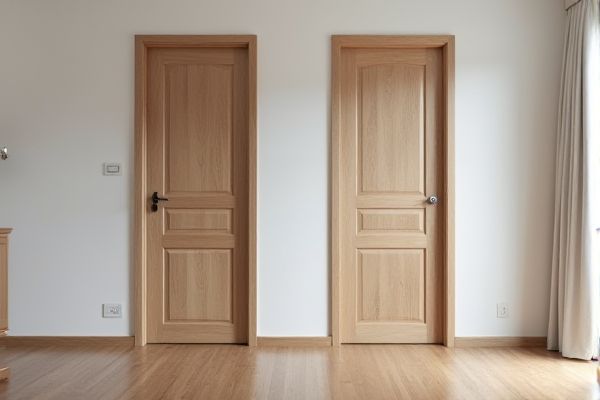
Closet pocket doors save space by sliding into the wall, making them ideal for small rooms, while sliding doors operate on a track outside the closet, offering easier access to the entire closet at once. Discover which door style best suits your space and lifestyle by reading the rest of the article.
Table of Comparison
| Feature | Closet Pocket Door | Sliding Door |
|---|---|---|
| Space Efficiency | Maximizes room space; door slides inside wall cavity | Requires wall space beside closet; door slides on external track |
| Installation | More complex; needs wall modification for pocket | Simple; mounted on surface tracks |
| Cost | Higher; due to framing and custom work | Lower; simpler hardware and installation |
| Aesthetics | Flush and clean look; door is hidden when open | Visible door when open; can feature decorative panels |
| Maintenance | May require wall repairs if track issues occur | Easier access for track cleaning and repairs |
| Durability | Track inside wall less exposed; potentially longer lifespan | Track exposed; susceptible to dirt and damage |
| Accessibility | Door slides fully into wall; full opening access | Partial opening; door overlaps when slid |
Introduction to Closet Pocket Doors and Sliding Doors
Closet pocket doors slide seamlessly into the wall cavity, saving space and creating a sleek, unobtrusive look that enhances room flow. Sliding doors, mounted on exterior tracks, offer flexible design options and easy access without requiring extra floor space. Choosing between your closet pocket door and sliding door depends on your room layout, space efficiency needs, and aesthetic preferences.
Design Differences: Pocket Door vs Sliding Door
Pocket doors slide into a wall cavity, offering a hidden, space-saving solution that maintains clean lines and maximizes room area. Sliding doors, mounted on an external track, provide easier installation and a visible design element while requiring wall space beside the opening. Both designs optimize functionality, but pocket doors excel in seamless integration, whereas sliding doors emphasize accessibility and decorative appeal.
Space Efficiency Comparison
Closet pocket doors maximize space efficiency by sliding fully into the wall, eliminating the need for clearance around the doorway and allowing for unobstructed floor space. Sliding doors, while also space-saving, require overlap and rail systems, which consume some usable closet width and floor area. Choosing pocket doors offers a superior solution for narrow rooms or tight spaces where every inch of floor area is critical.
Installation Process and Requirements
Closet pocket doors require precise framing within the wall cavity, demanding removal of existing drywall and reinforcement for the door jamb, which often increases installation complexity and time compared to sliding doors. Sliding doors, mounted on exterior tracks, generally need less structural modification and can be installed directly onto existing wall surfaces, making the process quicker and less invasive. Both types benefit from accurate measurements, but pocket doors necessitate a deeper wall space of at least 4.5 inches to accommodate the door panel.
Aesthetic Appeal and Style Options
Closet pocket doors offer a sleek, minimalist look by disappearing into the wall, maximizing space and maintaining clean lines that suit modern and contemporary interiors. Sliding doors come in a variety of materials, finishes, and panel designs, providing versatile style options that complement traditional, rustic, or eclectic decor. Your choice between these doors will influence the room's visual flow and overall aesthetic harmony, balancing both function and design preferences.
Durability and Maintenance
Closet pocket doors offer durability through their recessed design, minimizing exposure to damage while requiring occasional track cleaning to maintain smooth operation. Sliding doors, although durable with robust rollers, are more prone to wear on exposed tracks and may demand regular lubrication and alignment checks. Your choice should consider the ease of maintenance versus the long-term resilience offered by each door type in your specific space.
Functionality and Accessibility
Closet pocket doors save space by sliding seamlessly into the wall, offering unobstructed access to the entire closet without swinging into the room. Sliding doors, mounted on external tracks, provide a smooth operation but may limit access since only one side opens at a time. Your choice between these options should consider room layout and how easily you need to reach your closet contents.
Cost Analysis: Pocket Door vs Sliding Door
Pocket doors typically cost more to install than sliding doors due to the need for wall modifications and additional hardware. Sliding doors generally have lower material and labor costs, making them a budget-friendly option for closet access. Maintenance expenses for pocket doors might increase over time because of track repairs and wall access, whereas sliding doors often require simpler adjustments and fewer repairs.
Pros and Cons of Each Door Type
Closet pocket doors save space by sliding into the wall, making them ideal for small rooms, but they require wall modification and can be costly to install or repair. Sliding doors offer easy access with no swing space needed, suitable for wider closets, but may have limited opening width and track maintenance issues. Choosing between these door types depends on available space, installation constraints, and desired aesthetic.
Choosing the Best Closet Door for Your Needs
Closet pocket doors maximize space by sliding discreetly into the wall, ideal for small rooms where every inch counts, while sliding doors run along the outside of the closet, offering easy access without requiring wall modifications. Your choice depends on available wall space, installation complexity, and maintenance preferences, with pocket doors typically requiring professional installation but providing a cleaner look. Consider the room layout and usage frequency to select the closet door that best balances functionality and design for your needs.
 homyna.com
homyna.com